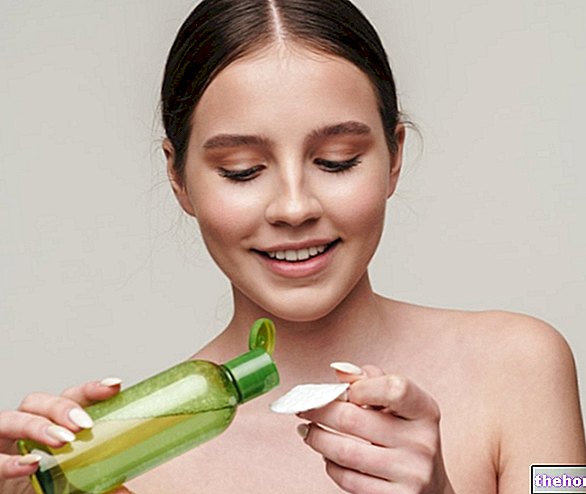Introduction
The do-it-yourself face masks are completely natural cosmetic recipes, to be made comfortably at home, quickly, easily and at low cost.

Clay masks
DIY clay face masks are very easy to prepare, much more than you might think.
Many women (and also many men) make an appointment with the beautician for a clay mask, mistakenly believing that a lot of experience is needed to carry out such a beauty treatment. In reality, the recipe for a clay mask is quite straightforward: the clay is easily available in herbalist's, perfumery's or in specialized shops. The biggest obstacle, in these cases, is not so much the preparation of the mask itself, but rather the choice of the most suitable type of clay for one's skin type.
For example, while sensitive skin requires delicate clays (white clay), useful for soothing and softening the skin, acne-prone skin can be improved with green clay masks. Otherwise, dull facial skin needs to be toned and revitalized. : for this purpose, DIY face masks with pink clay are the most appropriate.
At this point, after having identified the most suitable type of clay, you can proceed with the preparation of the do-it-yourself mask.
Below are two examples of recipes for making different DIY clay face masks.
Anti-acne clay mask
As mentioned, green clay is the most suitable for acne-prone skin. However, red clay is also able to exert a purifying action, but more delicate than green.
In this recipe, the creation of a do-it-yourself anti-acne mask with red clay is proposed.
Ingrediants
- 30 g of red clay, about a tablespoon (anti-acne and skin-purifying properties)
- 2 teaspoons of oat flour (exfoliating properties)
- 3 tablespoons of rose water (astringent properties)
- 1 drop of rose essential oil (antiseptic and aromatic properties)
- 1 drop of frankincense essential oil (antimicrobial, stimulating and revitalizing properties. In addition, the essence is used as a natural healing and immunostimulant)
- 1 drop of bitter orange essential oil (aromatizing, antiseptic and stimulating microcirculation properties)
Preparation
- Mix the clay and oatmeal quite vigorously. Add the rose water and mix everything until you get a homogeneous mixture.
- Next, add the other ingredients one by one, continuing to mix.
Spread the mixture on the skin of the face, avoiding spreading the mask on the lips and around the eyes. - Lie down and relax for 15 minutes.
- Remove the DIY mask with warm water and apply a specific acne cream.
Clay mask for dry, sensitive and tired skin
In this recipe we propose the use of white clay, the most delicate of all the various types of clay.
Ingrediants
- 30 g approx. of white clay
- 3 tablespoons of orange flower water (skin toning and regenerating activity)
- 1 teaspoon of liquid jojoba wax (antioxidant, emollient, sun protection properties)
- 2 drops of chamomile essence (antiseptic, anti-inflammatory and soothing properties)
- 2 drops of orange essential oil (aromatizing, tonic, antiseptic and stimulating properties of the microcirculation)
Preparation
- In a plastic or ceramic container (avoid metal ones) add the orange flower water to the clay, and mix well until a thick mass is obtained.
- Then, slowly add all the other ingredients, one at a time, continuing to mix.
- Spread the DIY mask on the face and neck, avoiding the lips and eye area.
Leave on for 15 minutes. - Rinse with warm water and, after drying the face, apply a tonic and / or a specific cream for sensitive skin.
Exfoliating mask
The emollient and antioxidant action of honey can be combined with gently abrasive substances such as potato starch or oat flour to obtain a DIY face mask with an exfoliating action.
It is possible to add a few drops of lemon juice to fortify the abrasive action (given by the malic acid contained in the lemon) of the face mask.
To prepare this beauty product, simply mix a tablespoon of potato starch (or oat flour if you want a more vigorous action), 1 tablespoon of honey and a little lemon juice, in the right quantity up to obtain a soft and spreadable dough.
Apply the product on cleansed and dry skin with circular movements (to favor the exfoliating action); leave on for about ten minutes. After the necessary time, remove gently with warm water.
Refreshing mask
The do-it-yourself cucumber masks, which are also very simple to prepare, are refreshing and purifying. Cucumber is, in fact, a vegetable used since ancient times to thoroughly purify imperfect and oily skin, giving a pleasant sensation of freshness The cucumber pulp goes perfectly with white clay and white yogurt. The DIY cucumber face mask can be enriched with mint essential oil or with pieces of mint leaves.
Let's see how the two cucumber masks are prepared.
Cucumber and white clay mask
To prepare a refreshing and calming DIY mask, suitable for all skin types, proceed as follows:
- Blend the pulp of a cucumber together with about twenty mint leaves. Let the mixture rest for 5 minutes before filtering everything.
- After this time, mix the filtrate with a spoonful of white clay, until it forms a viscous and sticky cream with the right density.
- Apply and leave on for 10-15 minutes. Then rinse with water.
This DIY face mask is designed to refresh the skin after a stressful and tiring day.
Cucumber and yogurt mask
When you don't have white clay, the cucumber mask can be made using plain yogurt instead of clay.
In this case, however, the cucumber pulp blended with the mint leaves forms a rather fluid mixture: applying it directly to the skin, this "mask" would drip because it is too liquid. To form a thick cream, it is therefore necessary to add a little white flour or - if you also want to exploit the exfoliating effect - oat or spelled flour.
Fruit masks
Fruit blended or pulped can soon be transformed into an "excellent do-it-yourself" mask with an energizing, toning, moisturizing, smoothing and stimulating action.
Fruits such as peaches, bananas and apricots are particularly rich in sugars and, for this reason, they are suitable for making do-it-yourself masks with a softening and moisturizing action.

Homemade fruit masks also boast remineralizing properties: remember, in fact, that minerals such as zinc, selenium and potassium abound in many fruits. Not to mention the concentration of vitamins (especially ascorbic acid) in fruit, especially citrus.
Anti-aging mask
A DIY face mask made by combining yogurt, honey and olive oil is the ideal recipe to soften and nourish dry, chapped and mature skin, because:
- Honey softens the skin, makes it more elastic and firmer: it is an active ingredient particularly suitable for preparing do-it-yourself face masks with an emollient, restorative and antioxidant action.
- Yogurt - an excellent base for making do-it-yourself face masks - tones the skin leaving a pleasantly refreshing sensation. Yogurt tends to be quite fluid, therefore it is often combined with a part of flour (or starch) which makes the mixture more dense and easily spreadable.
- The "olive oil", exercising anti-wrinkle, sebum-restoring, nourishing and protective properties, is an excellent natural ingredient (easily available) to prepare do-it-yourself face masks with anti-aging and anti-wrinkle action.
Pumpkin mask
Pumpkin DIY face masks are indicated for deeply moisturizing, smoothing and purifying the skin.
The preparation of this natural facial treatment is very simple:
- After steaming (or baking) the pumpkin and seeds, crush a part of the pulp by mixing it with a part of its seeds and a tablespoon of honey.
- Apply the mixture obtained on the face and leave on for 10-15 minutes, then proceed with rinsing.
After applying this mask, the skin of the face appears visibly cleaner and hydrated. Pumpkin masks are also an ideal natural remedy against sunburn.
Mask with egg white and lemon
Do-it-yourself face masks with egg white and lemon juice are very useful for exerting a purifying and regenerating action on the skin. The preparation method is simple:
- Separate the egg white from the yolk of an egg and - with the help of a fork - beat the egg white until a "frothy" consistency is obtained.
- Then, incorporate the lemon juice into the beaten egg white. Then continue to whip the mixture until a foam is obtained.
- Apply the mixture thus obtained on the face and leave for 15 minutes. After this time, rinse well with warm water.

The egg yolk, on the other hand, is mostly used in the creation of do-it-yourself face masks with a nourishing action, inside which it is often mixed with honey, olive oil and lemon juice.
Conclusions
Those just described are just some of the countless examples of do-it-yourself face masks that you can easily make at home.
Depending on the type of skin and the imperfection to be healed, you can have fun (and relax) in devising small cosmetic creations that are completely natural and beneficial for body and mind.
The only recommendation is to use caution in adding essential oils to clay, yogurt or fruit: the essences, in fact, if used in excessive quantities, can sensitize the skin and transform the do-it-yourself face masks into terrible irritating preparations.
Clearly, those allergic to essential oils should avoid embellishing the do-it-yourself face masks with essences. At the same time, in case of allergy to any of the ingredients present in the aforementioned recipes, these products should not be added to the do-it-yourself face masks (possibly, where possible, they can be replaced by ingredients with similar properties).























-nelle-carni-di-maiale.jpg)




